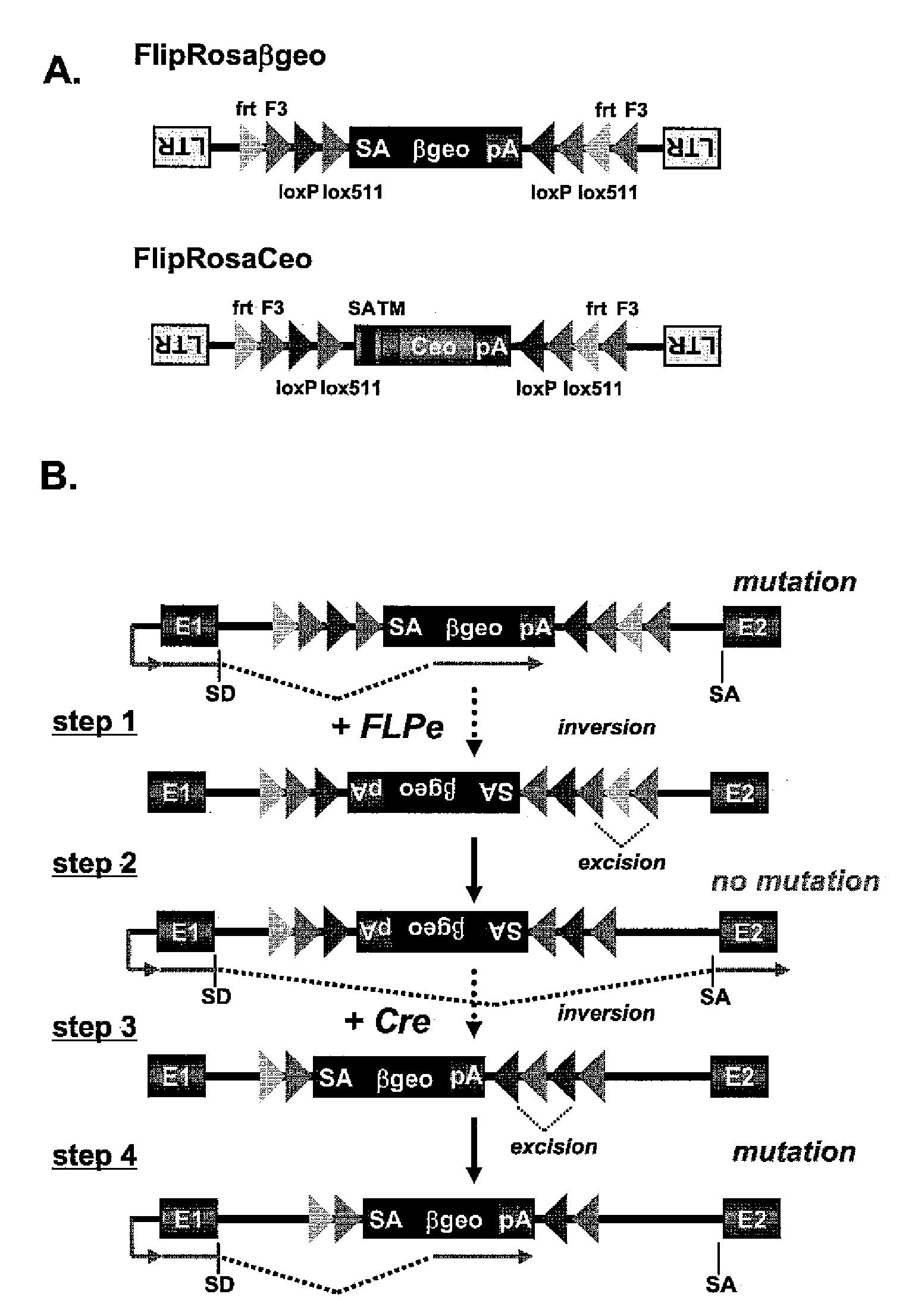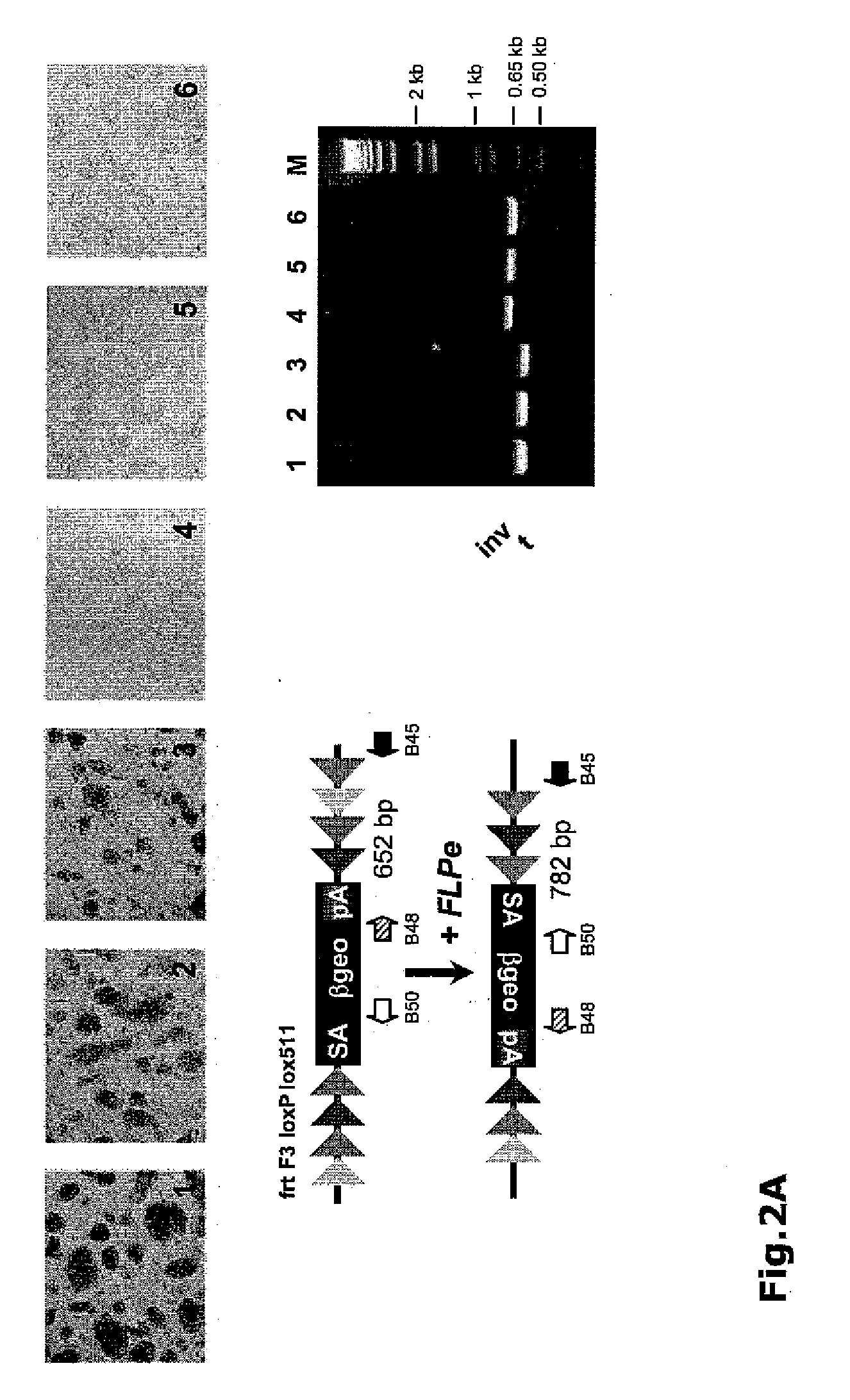Gene trap cassettes for random and targeted conditional gene inactivation
a gene inactivation and cassette technology, applied in the direction of instruments, organic chemistry, viruses/bacteriophages, etc., can solve the problems of affecting the effect of the trapped gene on human disease, laborious, time-consuming, and expensive and relatively inefficient inversion, and the inversion is predominantly unidirectional
- Summary
- Abstract
- Description
- Claims
- Application Information
AI Technical Summary
Benefits of technology
Problems solved by technology
Method used
Image
Examples
example 1
Vector Design
[0093]Two gene trap vectors were designed for large scale conditional mutagenesis in ES cells. The first vector FlipRosaβgeo contains a classic splice acceptor (SA)-β-galactosidase / neomycintransferase fusion gene (βgeo)-polyadenylation sequence (pA) cassette inserted into the backbone of a promoter- and enhancerless Moloney murine leukemia virus in inverse transcriptional orientation relative to the virus (FIG. 1A) (Friedrich, G. & Soriano, P. (1991) Genes Dev. 5, 1513-1523). The second vector FlipRosaCeo is similar to FlipRosaβgeo except that SAβgeo has been exchanged with Ceo, which is an in frame fusion between the human CD2 cell surface receptor- and the neomycin resistance genes (Gebauer, M. et al., Genome Res 11, 1871-7 (2001)). Unlike βgeo, Ceo does not require an extra splice acceptor site for trapping as it contains a powerful cryptic 5′ splice site close to its 5′ end. Moreover, Ceo encodes a type II transmembrane domain, which favors the capture of signal seq...
example 2
Gene Trap Cassette Inversions in ES Cells
[0095]To test for recombinase-mediated inversions, several FlipRosaβgeo-trapped ES cell lines were selected for high levels of βgeo expression using X-Gal staining. X-Gal positive (blue) cell lines were then transiently transfected with FLPe or Cre expression plasmids and emerging subclones were stained with X-Gal. As shown in FIG. 2, exposure of the gene trap lines to either FLPe (FIG. 2A) or Cre (FIG. 2B) yielded a mixture of X-Gal positive (blue) and X-Gal negative (white) subclones, indicating that several cell lines have ceased to express βgeo. To test whether this was caused by recombination, we isolated DNA from both the blue and the white sub-lines, and subjected it to an allele-specific PCR. FIGS. 2 (A and B) shows that, in each case, the amplification products obtained from the blue and white clones corresponded to a normal and to an inverted gene trap allele, respectively. Taken together, the results indicate that both FLPe and Cre...
example 3
Reversibility of Gene Trap Mutations
[0097]To test whether the mutations induced by the conditional gene trap vectors are reversible, we selected the Q017B06 and M117B08 gene trap lines for further analysis. In Q017B06, the FlipRosaβgeo gene trap vector disrupted the retinoblastoma binding protein 7 (RBBP7) gene at the level of the first intron. In M117B08, the FlipRosaCeo gene trap vector disrupted the glycosyltransferase 28 domain containing 1 gene (Glt28d1) in the 10th intron. Both genes are located on the X-chromosome of a male derived ES cell line, which provided a haploid background for the mutational analysis. As shown in FIGS. 3 and 4, (panels B and C), the RBBP7 (FIG. 3) and Glt28d1 (FIG. 4) genes were both expressed in the wild-type cells as expected. However, expression was either blocked (RBBP7, FIG. 3) or severely repressed (Glt28d1, FIG. 4) by the gene trap insertions. Both trapped cell lines instead expressed fusion transcripts as a result of splicing the upstream exon...
PUM
| Property | Measurement | Unit |
|---|---|---|
| Fraction | aaaaa | aaaaa |
| Length | aaaaa | aaaaa |
| Length | aaaaa | aaaaa |
Abstract
Description
Claims
Application Information
 Login to View More
Login to View More - R&D
- Intellectual Property
- Life Sciences
- Materials
- Tech Scout
- Unparalleled Data Quality
- Higher Quality Content
- 60% Fewer Hallucinations
Browse by: Latest US Patents, China's latest patents, Technical Efficacy Thesaurus, Application Domain, Technology Topic, Popular Technical Reports.
© 2025 PatSnap. All rights reserved.Legal|Privacy policy|Modern Slavery Act Transparency Statement|Sitemap|About US| Contact US: help@patsnap.com



